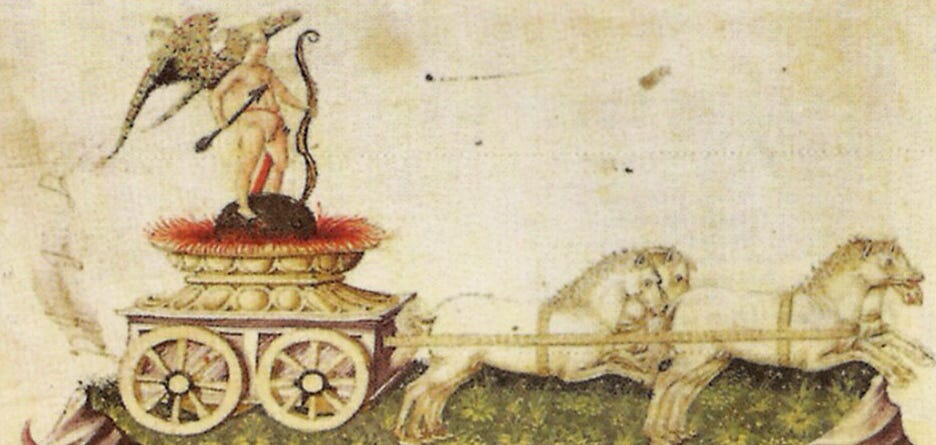Thoughts on Jonathan Pageau's Symbolism Masterclass
Lesson 1: Piercing Through the Secular Mind with Symbolism
In our present age of zombie newsfeeds, the remedy is to turn our attention back to the most generative stories we know—the ones that have survived the Darwinian pressures of time. In other words, deep mythos is fundamental to how we live. The deepest, oldest stories connect us to real embodied intelligence instead of abstraction and ideology. The virtue of Jonathan Pageau's new Symbolism Master Class is its clear-minded argument for symbolic and, therefore, religious thinking and storytelling.
The alternative to understanding symbolism is to be captivated by unconscious symbols and egregores: to be Moloch for clickbait and citizens of a veritable idiocracy, building outrageous towers of babble with no enduring value, bound to fall into the noise of modernity. There is no way around religious mythos, which becomes bastardized ideology when repressed or denied.
Unlike random facts or philosophical propositions, symbols have the logic of lived experience. They inhabit the subterranean world of culture; they guide us for good or ill. We live in a world of ‘stories,’ not of disembodied facts or objects. Embodied liturgy, myth, and religious practice are essential to remedying the present and perennial meaning crises.
Note: I’m not an Orthodox Christian like Pageau, but a Vajrayana Buddhist, which is a radically symbolic path. “California Buddhists,” as Pageau sarcastically calls them (and I would add neo-Advaita non-dualists, Zen protestants, and other spiritual riff-raff), could learn much from Jonathan Pageau. Buddhism, like all religions, has a rich language of symbolism. Real Buddhism is full of the same kinds of fantastical supernatural stories that you will find in any religion, which, if understood symbolically, is a feature and not a flaw.
Pageau’s favorite phrase is “symbolism happens.” He tells us to pay attention to symbols—to meditate, contemplate, and work through symbols—individually, religiously, and communally. We need to become symbolically literate.
Attentio to religious symbols is Love and is expressed as agape and eros. Agape love requires distance—a symbol creates tension and unrequited feeling. Erotic love requires both this erotic closeness and agapic distance. Christian moralists tend to separate agape and eros, but they are two sides of the same coin. We are in a creative/erotic relationship with divine reality. We are an analogy of that reality.
Pageau speaks of sexual union as being a symbol of divine communication. In sexual union, we are not ‘one’ and ‘not two,’ as they say in Zen. We are not a bland oneness without distinction, yet we are not two separate entities. In the East, this is symbolized by the Yab-Yum—or the deity in a sexual embrace. Sex is our best metaphor for divine relationship, for the bringing together of heaven and earth.
In my mind, the central takeaway is that we know things through analogy. Contemplating symbols helps us find meaning, coherence, direction, and understanding. Language and image are, by nature, symbolic, analogical, and allegorical. The word “dog” symbolizes the unknowable mystery of a dog. We know what a dog is through the symbol of a dog. Everything we know is a symbol, even the atom. We are symbol-making creatures par excellence, living in a world of interdependent and dynamic symbols, moving up and down hierarchies of value. Symbols are the threshold of mystery—icon portals to divine unknowing.
Pageau points out that this unknowability of God can be taken to an extreme called nominalism. To the nominalist, God cannot be described and is therefore unknowable through human reason and expression; hence, no analogy, no symbol of God is possible. Univocalism is the opposite proposition: God is in all appearances and is equivalent to nature.
On the one hand, we posit a God so high and mighty that there is no analogy to humanity; on the other, we posit a God so low that He doesn’t need to be named. We kill God through the tyranny of the nominalist God (especially, but not exclusively, in Islam) and the anarchy of the univocal God, leading to materialistic nihilism (especially, but not exclusively, in liberal progressivism). The fundamentalist kills God in his false Jihad because he is too violent and abstract; we can’t make an intimate connection to Him. The nominalist kills God because He or She is everything and therefore nothing—God can be Gaia, Elvis, the great dictator, or anything at all. On one hand, we have eternalist and Platonic absolutism leading to totalitarianism; on the other, we have nihilism leading to the "end-of-the-world" sex party and neo-paganism. But God never really dies; it is just our limited idea of the divine that must be crucified.
We are what we love, what we pay attention to. The entire religious thrust is about directing our attention to the highest point of meaning, for our transformation. Focusing attention on what is divine, beautiful, and powerful cascades down into the world. But if you kill the transcendental principle, as Nietzsche says, you might never wash the blood from your hands. And this is more or less the story of modern liberal secularism—or a life without divine attention, divine ritual, and divine symbol: the life of a zombie, or the last man. Therefore, bringing our attention back to those divine symbols means everything. In all the great traditions!


